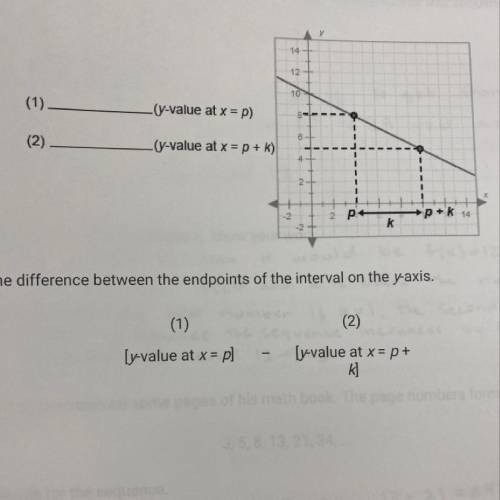Prove that linear functions grow by equal differences over equal intervals.
Part l. This...

Mathematics, 25.02.2020 01:05 giovannymarvez16
Prove that linear functions grow by equal differences over equal intervals.
Part l. This is the graph of y=-1/2x+10 Use the graph to show equal intervals of x-values have equal differences of y-values.
a) think about an interval on the axis starting with p + k. What is the difference between x-values? What is the difference between the y-values for these x-values? Complete the table using y=-1/2+10.
b) The difference in the x-values for each interval is ___. This value is also constant because =-1/2(p+k)+10-(-1/2p+10)
=-1/2p-1/2k+10+1/2p-10
=-1/2k
d) Does your answer in part c depend on p? If not, what does it depend on?
Part ll. Use a similar method to prove that for any linear equation, y=mx+b, equal intervals result in growth by equal differences.
Step 1: If the equal interval is k, the two endpoints of the interval will be labeled p and p + k. Label the endpoints of the corresponding interval on the y-axis of the graph below. Hint: First, substitute x=p into y=mx+b. Next, substitute x=p+k into y=mx+b
Step 2: Find the difference between the endpoints of the interval on the y-axis.
(1)
[y-value at x=p]-
(2)
[y-value at x=p+k]


Answers: 1
Another question on Mathematics


Mathematics, 21.06.2019 17:00
Tiffany drives 285,120 feet before lunch and 628,320 feet after lunch. about how many kilometers does she drive all together
Answers: 1

Mathematics, 21.06.2019 19:30
Find the 6th term of the expansion of (2p - 3q)11. a. -7,185,024p4q7 c. -7,185p4q7 b. -7,185,024p6q5 d. -7,185p6q5 select the best answer from the choices provided a b c d
Answers: 1

Mathematics, 21.06.2019 23:00
The equation shown below represents function f. f(x)= -2x+5 the graph shown below represents function g. which of the following statements is true? a. over the interval [2, 4], the average rate of change of f is the same as the average rate of change of g. the y-intercept of function f is less than the y-intercept of function g. b. over the interval [2, 4], the average rate of change of f is greater than the average rate of change of g. the y-intercept of function f is greater than the y-intercept of function g. c. over the interval [2, 4], the average rate of change of f is the same as the average rate of change of g. the y-intercept of function f is greater than the y-intercept of function g. d. over the interval [2, 4], the average rate of change of f is less than the average rate of change of g. the y-intercept of function f is the same as the y-intercept of function g.
Answers: 1
You know the right answer?
Questions






Mathematics, 05.05.2020 00:03

History, 05.05.2020 00:03


Mathematics, 05.05.2020 00:03

History, 05.05.2020 00:03



Mathematics, 05.05.2020 00:03

Mathematics, 05.05.2020 00:03


Mathematics, 05.05.2020 00:03


English, 05.05.2020 00:03


Mathematics, 05.05.2020 00:03



